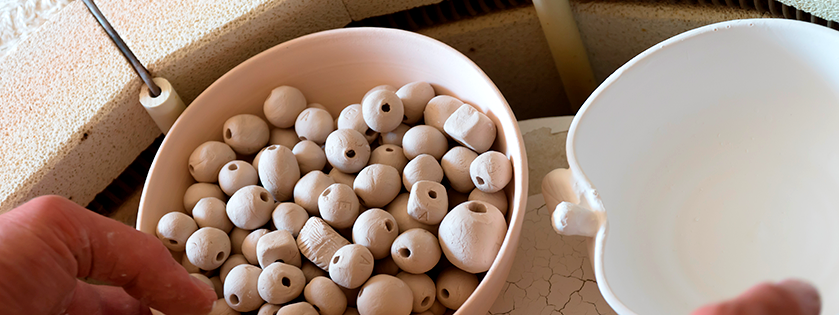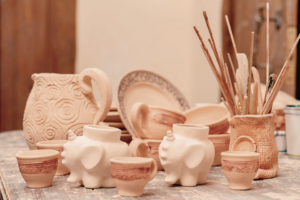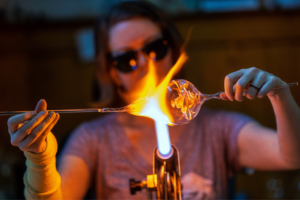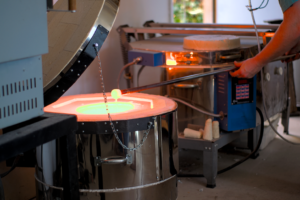Nowadays, potters and artists everywhere are most likely to choose electric ceramic kilns to fire all their creations. Electric kilns offer simplicity and reliability at a rather accessible price point. This type of kiln will certainly make loading and firing a simple task while performing with high efficiency.
How do electric ceramic kilns work?
An electric ceramic kiln consists of a closed chamber made from soft, porous, highly insulating bricks. There are channels that run inside its interior walls, where coils made from a special allow will run and act as heating elements.
A high electric current is sent through these coils causing friction and eventually, heating up the whole chamber. It is then that the kiln is ready to start firing ceramic pieces. The heat produced inside a ceramic kiln is evenly spread and easily controlled, therefore being a reliable firing method.
There is the possibility to fire an electric kiln manually or with the aid of digital controllers, as seen in more recent models. Computer-controlled programming is available in certain cases, allowing for control over the firing process from beginning to end. Low and mid-fire ceramic work is the most recommended for this type of firing method since the coils in an electric kiln tend to wear out if constantly put under the strain of high firings.
Firing pieces in ceramic kilns is sure to familiarize you with the concept of ‘cones’. Cones are pieces of ceramic that indicate the level of temperature that has been reached. They also help you gauge if the temperature has increased at the optimal rate and if the kiln has been at the right temperatures throughout the firing schedule for the correct amounts of time.
Firing up to a certain cone refers to a way of measuring ‘heat-work’, which is a combination of the temperature reached, and the time it took to become that hot.
Potters usually use cones in certain ranges to identify the specific conditions under which a piece was produced. These ranges are defined on a cone chart that starts at cone 022, which about the lowest cone available for firing pottery, going all the way up to cone 14. Some industrial products go over cone 14, but these are rarer cases.
The higher the number on the cone chart, the higher the temperature reached. Make sure to interpret numbers as negative when preceded by a zero, and as positive when surpassing number 1. The zero acts as a minus sign, so cone 022 is lower than 014, cone 010 is lower than cone 3, etc. You can read cone levels on a spectrum that is defined as follows:
- Cone 022: Very low firing
- Cones 06 – 04: Bisque fire / bisque scale
- Cones 00 – 1 – 3: Lower mid range
- Cones 5 – 6: Mid fire range
- Cone 10 : High fire range
Different loading styles for electric ceramic kilns
When selecting an electric kiln for purchase, you will find that there are two different designs, based on their loading style: front-loading and top-loading.
Usually, front-loading ceramic kilns are made with a heavy steel frame to support the soft brick interior. The support structure is made from steel bracing (usually angle iron) fused with flat steel sheets that are often painted. This kind of kiln is usually more expensive than its counterpart, sometimes even doubling the price point.
Front-loading kilns are easier to load, making the process of firing a lot more efficient. They are also more durable, being the perfect option for more high-demand spaces like schools or manufacturing workshops. It is also a better choice if you plan to fire pieces at higher temperatures on a constant basis.
A more cost-efficient option would be a top-loading electric kiln. They are designed as a chamber with a lid that is hinged and functions as a door for the kiln. To load it, works need to be lowered into the firing chamber while standing over the kiln opening.
Most people looking to produce small ceramic batches choose this option because it is budget-friendly. Top-loading kilns are the most popular for a reason. You’re able to produce any sort of project at a lower cost, so your investment is better distributed. You may want to have a larger selection of materials or finishes, and getting a top-loading kiln will allow you to manage the costs of setting up and furnishing a full studio much more effectively.
JPSKilns has a variety of ceramic kilns that have different capabilities in order to adapt to your firing needs conveniently. These kilns will safely ensure that heat radiates evenly throughout the whole chamber, allowing your projects to absorb all the heat that they need to become fully formed.
Electricity requirements
It is extremely important to consider the electricity requirements of your electric kiln. In residential contexts, you might commonly find that either 120-volt or 240-volt single-phase outlets are available.
If working in an industrial or school area, 208-volt or even 480-volt outlets might be what is in place. Voltage is decided by the power you have available to you, so you need to confirm if the sort of voltage requirements needed for your kiln is available in your location before making a purchase. An electrician can provide an estimate and can install a breaker that meets the proper amperage requirements for the electric kiln of your selection.
Advantages of using ceramic kilns
There are many reasons why electric ceramic kilns are one of the most popular choices for potters nowadays. One of the most significant benefits of using an electric ceramic kiln over a more traditional one is the speed at which it heats up and cools down. The best electric kilns are much faster at both processes, making them a lot more convenient for amateurs and professionals alike.
They are also rather flexible in terms of what they can be used for. Because of their usual size, there is no need to have a large number of pieces to fully load the chamber, making it ideal for testing glazes, clays, decals, lusters, and other firing processes. Since more contemporary models are programmable, electric kilns are rather convenient. Constantly supervising the kiln isn’t necessary as it is with gas or wood-fired kilns.
Electric kilns with an automatic programmer are definitely the most reliable and accurate option, since firing schedules may be easily adjusted as needed.
Contact our team to acquire the best kilns!
While choosing your first kiln may be a daunting task, considering all the previously mentioned is certainly going to take you in the right direction. In general, electric kilns are easier to handle, so your needs will guide the rest of the requirements to choose. Electric kilns are not only a great option for artists who are newly introduced to the practice of ceramics, but also for trained professionals who are looking for a convenient and accessible alternative to more traditional firing methods. ¡Ceramic kilns for sale at JPS Kilns!








